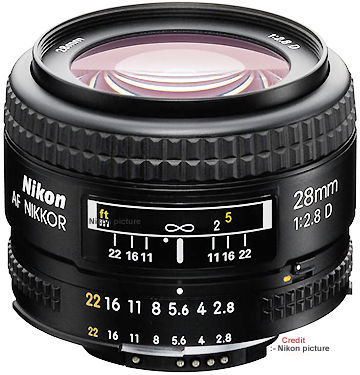 |
Nikon AF-Nikkor 28mm f/2.8D wideangle lens |
The most inviting factor for photographers on this 28mm wideangle lens is with its AF-D lens configuration - I guess others are secondary. Weighing just 210g, it is slightly heavier from the previous non-D version which weighs lighter at 195g. The weight gain seemingly has to do with the new 6 elements in 6 group internal optical design where more lens elements were being used. Further, the AF-D lens has a much improved physical built quality which reflects in its overall appearance. The manual focusing ring has a broader dimension as found in the earlier 2nd non-D update. Other minor improvements include the distance scale has the feet in colored. The minimum aperture lock has changed to a slide switch design as well as Nikon has maintained three depth of field scales for f/11, f/16 and f/22. Personally, I'd rather see additional scales such as a mid aperture of f/5.6 or f/4.0 being added (or replace one of them) which may even make this section more useful for photographers.
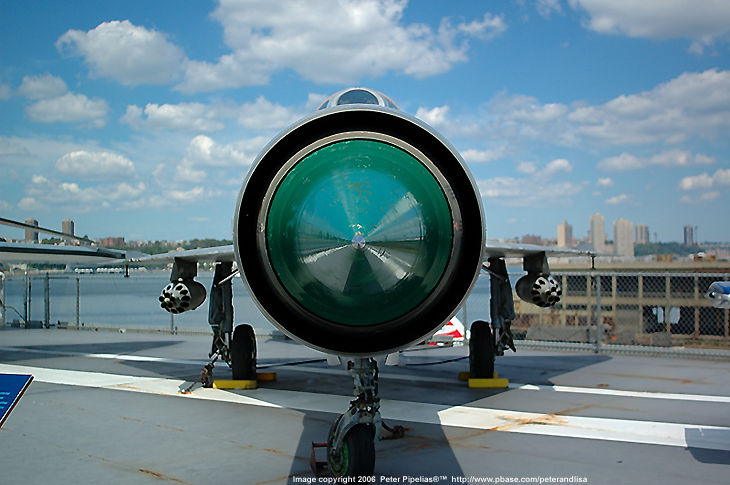 |
MIG-21 |
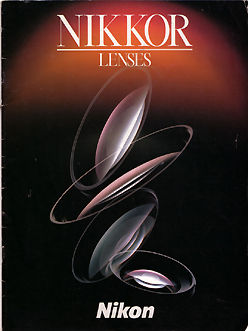 |
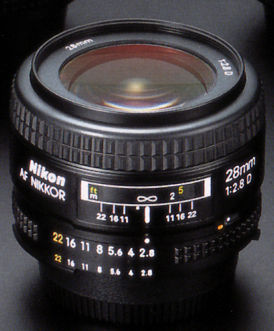 |
* Added note:- I don't intend to spice up a minor issue here. But it has puzzled me for for some time. In a lens product catalogue distributed in March, 1994; the lens data section mentioned the AF Nikkor 28mm f/2.8D has an old optical formula of 5 elements in 5 groups design. I have managed to get another copy published in July, 1994 as well as another sales guide of 1996/7 it has still stated with same description. All the concerned lens shared an identical physical appearance and looked exactly the same with later version with a revised 6 elements in 5 groups design. |
The earlier
AF-D stated it weighs 195g but new AF-D with 6E/6G weighs 205g. So, which is which
? If it ever these are existed, the AF-D 28mm f/2.8 may has two versions then. It
couldn't be a publication error that ran for a few years in a row right ? IF you have an Instruction
manual, check the spec sheet and see if which version you have. If your AF-D lens
has a 5E/5G, then the suspicion may has some basis then.
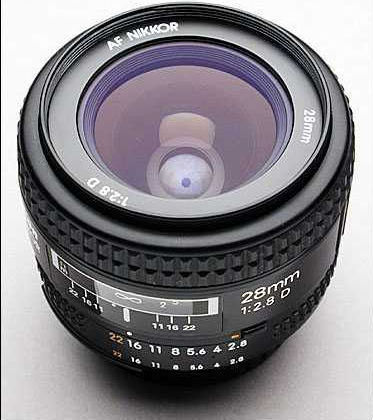 |
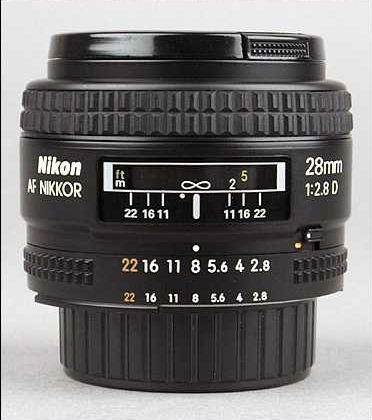 |
The version of AF-D 28mm shown in Roland Vink's S/N site. He concludes there is only ONE version of the AF-D 28mm f/2.8D exists. May be you can find out this and update me or him. |
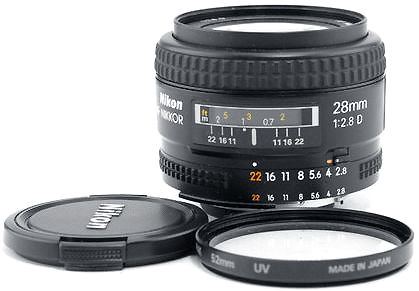 |
Key Features:-
|
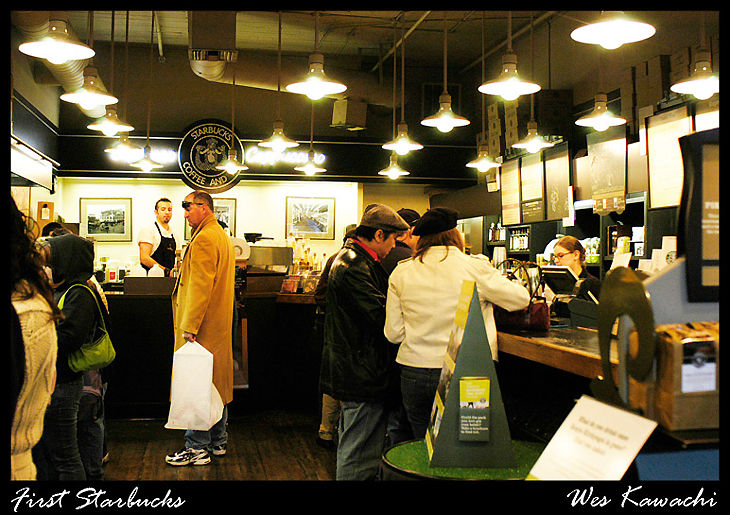 |
Inside a cafe... |
Depends from model to models, Nikon 3D Matrix Meters enables 3D Multi-Sensor Balanced Fill-Flash photography as well. The picture angle of the AF-D 28mm wideangle lens corresponds with most flash units Nikon offers and has this picture angle of 28mm wideangle lens covered . This provides even illumination for flash photography and you may take advantage from it. In terms of compatibility, this AF-D 28mm wideangle lens can be used with virtually all Nikon SLRs that has Ai-spec as well as all Nikon Digital SLR models in their respective performances for metering as well as exposure control. However, it is less functional on a DX format sensor D-SLR camera as the picture angle magnifies the primary 74° as an approx. 53° in a DX Format sensor Digital SLRs (28mm x 1.5 = 42mm 35mm equiv.). Overall, it performs its best at normal distance but there is an underlying photographic possibilities where you can also explore with close-up photography. The minimum marked distance scales is 0.25m (1 ft ) and delivers an impressive 1:3.9 magnification ratio. Nikon has incorporated Close Range Correction system in the lens design to ensures its outstanding optical performance even be extended to its closest focusing range. Lastly, due to its late release, the AF-D Nikkor 28mm f/2.8D wideangle lens has enjoyed an extra benefit of being treating with Nikon's Super Integrated lens Coating (SIC); the improved SIC which reputedly enhances performance of a Nikkor lens by reducing ghosting and maintain overall uniform color balance that characterizes Nikkor lenses. Due to nature of an wideangle lens has wider field of view; this is one functional part of Nikon technology for their products.
Is this autofocus Nikkor wideangle lens a worthy buy ? Errr ....with so many available options of AF Nikkor wide-tele zoom lenses around in the market today; you may think I am silly to encourage anyone of your to get one for yourself. Not quite. Recently, I did a search via Ebay, it is interesting to note that used AF Nikkor 28mm f/2.8N has a few Buy-It-Now prices that ranging from USD110.00 to USD160.00 (AF-D adds another 100.00 -150.00, it ranges). While a comparing AF Zoom Nikkor 28-70mm f/3.5~4.5D ranges from USD100.00 ~ 150.00; while the AF-S Zoom Nikkor 28-70mm f/2.8D IF-ED has a calling price of around USD1,000-00. So, may I ask where the hell you can find a Nikkor wide-tele zoom lens with a f/2.8 maximum aperture that sells at USD120.00 ? Some of you may think the AF Zoom Nikkor 28-70mm f/3.5~4.5D is a better buy as it has a more versatile zoom but its dim starting aperture (as well as larger, heavier in size and weight in comparison).
If you are looking forward to acquire a compact, lightweight 28mm wideangle lens for traveling in the lightest possible package; this lens fits the purpose. But if you have already owned a version in the AF Nikkor 28mm wideangle lens group, you don't actually need to get an upgrade. Unless all your current Nikon gears are digital-based, or using a Nikon that has 3D Matrix Metering embedded and yet intend to go for a prime 28mm wideangle for personal use, this AF-D 28mm version could justify a consideration as it extends its potential further through camera's technology at the other end. Well, for those who think they always had erroneous exposure in their photography and concluding the lack of 3D Matrix Metering is the cause - then you may have a long years ahead to suffer with your cash reserve. Nikon should be happy to hear this.
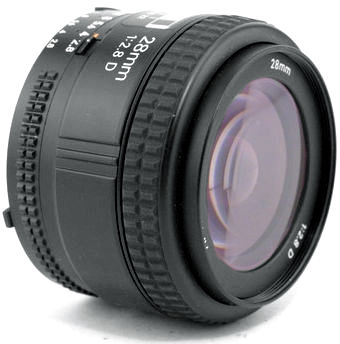 |
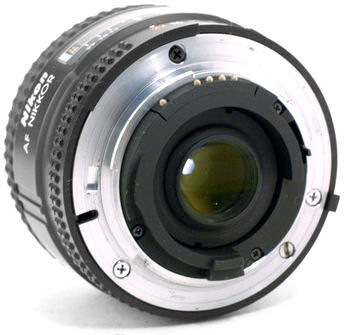 |
Credit: Image(s) courtesy of 'Shutterblade team' where I downloaded them from their Ebay Store. All image(s) appeared herein are Copyright © 2005. All rights reserved. |
Specifications
Focal length: 28mm; Maximum aperture: f/2.8D
Lens construction: 6 elements in 6 groups; with close range correction; IF,
floating lens element design
Picture angle: 74° (53° for DX Format sensor Digital SLRs: Lens coating:
Nikon SIC
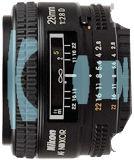 |
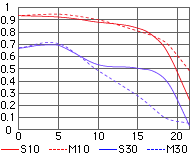 |
Distance scale: Graduated in meters and feet from 0.25m (0.85 ft ) to infinity (OO) |
Exposure
measurement: Via full-aperture method; distance info auto relay to camera body
meter and exposure circuitry
Mount: Nikon bayonet mount; External front filter attachment frame:
non-rotating
Depth of Filed Scales: yes. f/11, f/16 and f/22.
Infra-index: Yes. Filter attachment size: 52mm
Dimensions: Approx. 65mm dia. x 44.5mm
Weight: Approx. 205g
|
Standard Accessories (Supplied) |
Optional Accessories |
|
Snap-On front lens cap |
Flexible lens pouch No. 61 |
|
Rear lens cap LF-1 |
Hard lens case CL-30S, 34A, CP-8 |
|
Bayonet-type filters (L37C, A2, B2, 056) |
Teleconverter TC-201, TC-l4 A |
|
Filter case CA-2 |
Lens hood HN-2/HB-2 |
|
AF-3; AF-4 |
AF-3 usable. (0); AF-4: Usable. (1): Indicates maximum number of usable hoods (HN-36 for AF-3/HN-37 for AF-4). |
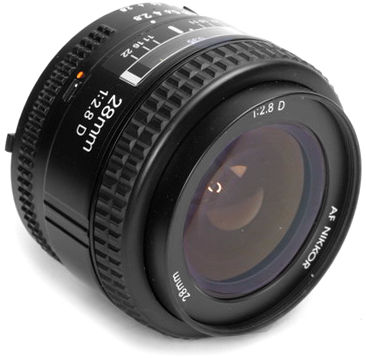 |
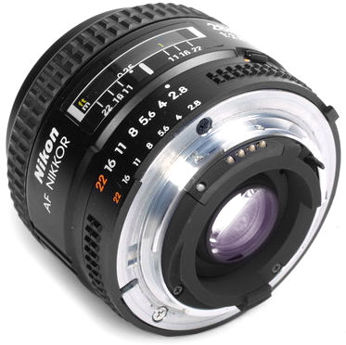 |
Credit: Image courtesy of Laura Kornylak ® <shutterblade@comcast.net> from shutterblade*com where the Company has a website on its own. Image copyright © 2003. All rights reserved. Please respect the visual property of the contributing photographer. |
 |
Minimum Aperture Lock For programmed auto or when during shutter-priority auto shooting, use the minimum aperture lock lever to jock the lens aperture at f/22. |
IMPORTANT NOTE: If the lens aperture ring has not been set to the minimum aperture, the viewfinder and control panel on top of the camera will show a "Fee" blinking , and the shutter release will be disabled. This does not apply in the case of type G lenses, which do not have an aperture ring. Use this setting when you want to adjust aperture using the lens aperture ring. Note that aperture for type G lenses is always set using the command dials.
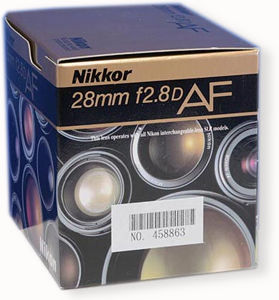 |
| NEXT | 2/3 One of the fastest lens speed in wideangle lens for 35mm SLR photography |
Main Index Page - Autofocus Nikkor lenses
| Message Board |
for your
Nikkor
Optics
in a shared environment
| Message Board | Specifically for Dispose or Looking for new/used Nikon/Nikkor photographic equipment
| Nippon Kogaku Rangefinder Resources | Nikon F | Nikon F2 | Nikon F3 | Nikon F4 | Nikon F5 | Nikon F6 | Nikkormat / Nikomat | Nikon FM Series | Nikon FE/ FA | Nikon EM/FG/FG20 | Nikon Digital SLRs | Nikon - Other models |
Nikon MF RF-Nikkor lenses for Rangefinder
cameras:-
Main Index Page
Nikon
Auto Focus Nikkor lenses:- Main Index
Page
Nikon
Manual
Focus
Nikkor lenses:-
Fisheye-Nikkor Lenses - Circular |
Full Frame |
Ultrawides Lenses - 13mm15mm18mm20mm |
Wideangle Lenses - 24mm28mm35mm |
Standard Lenses - 45mm 50mm 58mm | Telephoto Lenses
- 85mm105mm135mm180mm & 200mm |
Super-Telephoto Lenses - 300mm 400mm 500mm 600mm 800mm 1200mm |
 |
Special Application
lenses: Micro-Nikkor Lenses - 50mm~55mm -60mm 85mm -105mm 200mm Micro-Zoom 70-180mm Perspective Control (PC) - 28mm 35mm PC-Micro 85mm Dedicated Lenses for Nikon F3AF: AF 80mm f/2.8 | AF 200mm f/3.5 EDIF Depth of Field Control (DC): 105mm 135mm Medical Nikkor: 120mm 200mm Reflex-Nikkor Lenses - 500mm 1000mm 2000mm Others: Noct Nikkor | OP-Nikkor | UV Nikkor 55mm 105mm | Focusing Units | Bellows-Nikkor 105mm 135mm Nikon Series E Lenses: 28mm35mm50mm100mm135mm | E-Series Zoom lenses: 36~72mm75~150mm70~210mm |
MF Zoom-Nikkor Lenses: 25~50mm | 28~45mm | 28~50mm | 28~85mm | 35~70mm | 36~72mm E | 35~85mm | 35~105mm | 35~135mm | 35~200mm | 43~86mm | 50~135mm | 50~300mm | 70~210mm E | 75~150mm E | 80~200mm | 85~250mm | 100~300mm | 180~600mm | 200~400mm | 200~600mm | 360~1200mm | 1200~1700mm
Tele-Converters: TC-1 | TC-2 | TC-200 | TC-201 | TC-300 | TC-301 | TC-14 | TC-14A | TC-14B | TC-14C | TC-14E | TC-16 | TC-16A | TC-20E
Recommended links to understand more technical details
related to the Nikkor F-mount and production Serial Number:
http://rick_oleson.tripod.com/index-153.html by: my
friend, Rick Oleson
http://www.zi.ku.dk/personal/lhhansen/photo/fmount.htm by: Hansen,
Lars Holst
http://www.mir.com.my/rb/photography/hardwares/nikonfmount/lens2.htm
http://www.photosynthesis.co.nz/nikon/serialno.html
Recommended Reading Reference on Nikon cameras and Nikkor lenses | about this photographic web site
| | Back | Main Index Page of Nikkor Resources | Back | Main Index Page of Pictorial History of Nikon SLRs |
| Home - Photography in Malaysia |
![]()
Credit: To all the good
people who has contributed their own experience, resources or those who are kind
enough granting us permission to use their images appeared in this site Note:certain
content and images appeared in this site were either scanned from official marketing
leaflets, brochures, sales manuals or publications published by Nikon over the years
and/or contribution from surfers who claimed originality of their work for educational
purposes. The creator of the site will not be responsible for may discrepancies arise
from such dispute except rectifying them after verification."Nikon", "Nikkormat", "Nippon Kokagu
KK"
& "Nikkor" are registered
tradename of Nikon Corporation Inc., Japan. Site made with an Apple IMac.